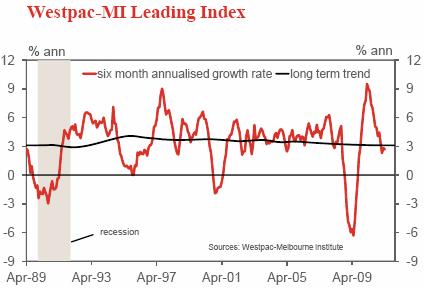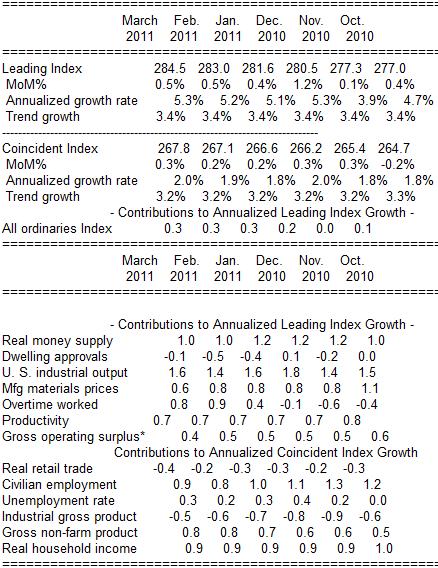
The Melbourne Institute/Westpac Leading Indicators Index is out today and shows that growth momentum in the economy has slowed. From the release (full report below):
The annualised growth rate of the Westpac–Melbourne Institute Leading Index, which indicates the likely pace of economic activity three to nine months into the future, was 2.7% in April 2011 below its long term trend of 3.1%. The annualised growth rate of the Coincident Index was 0.3%, well below its long term trend of 2.9%. The growth rates in both Indexes have seen significant downward revisions due to the incorporation of March quarter data. Westpac Senior Economist, Matthew Hassan, commented, “The scale of the impact ofweather disasters on the economy’s ongoing growth momentum is becoming more apparent. After previously running at just over 5%, the six month growth rate in the Index has been marked down to just 2.7%. That is marginally below the long term trend rate, indicating sub-par growth, but not overly weak. Moreover there are signsthat the worst of the hit has passed with the growth rate rising from the 2.3% raterecorded for February.
Mr Hassan warned that “assessing growth momentum so soon after a large negative shock like the weather events we saw at the start of the year is very difficult. These events have created significant distortions that will take time to drop out of the picture. As this happens we may continue to get conflicting signals. The good news so far is that even with the negative hit, the growth rate in the Leading Index does not appear to be so low as to be of major concern.”
No shit, Sherlock.
Now, I love economic data, the more the merrier. It’s always fun and often challenging to your views, so long as you’re not Mad Adam. But this is a tad silly. This index is supposed to be a leading indicator, yet it has just plunged on flood-effected data.
We can’t be too hard on the index, I suppose. You can’t predict a shock. But it is an interesting question to ask why this index is set up the way it is. Here’s a snap shot of what the index comprises (it’s not updated with latest data):

In my view, these components don’t make a whole of of sense. Money supply is fair enough. Dwelling approvals would be ok but it’s from April and we’re in late June, US industrial output is good but is hardly enough to capture the global effects that lead Australia’s economy. How about adding Chinese steel prices or production? Materials prices are also good, as is produucitivity and profits. I would have thought capex intentions would be quite useful to add.
I’m not sure why we should see lagging retail sales as a leading indicator, unemployment is definately trailing and should be replaced with job adds and the rest are from first quarter national accounts that is ancient history. Given the contrinbution that finance makes to GDP, credit growth would be good too.
I mean, what is the point of releasing leading indicators for April in late June?
Here’s a reader’s challenge. What’s you DIY leading indicator index?

